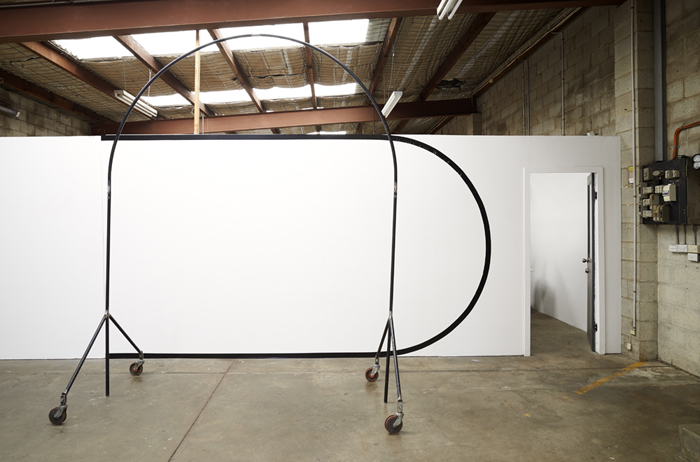 |
|
||||||||||||
Margaret Roberts blp-brake 2014, black floor tape, metal tubing & found wheels, built environment of F49 showroom, open 30 October - 8 November, Factory 49. Thanks to Phillip Spark. Photo: Sue Blackburn.
|
|||||||||||||
Blp-brake is a 7.2 metre blp made to fit the Factory 49 showroom. Blps have an attraction because they seem to encompass almost everything and nothing. They are a rectangle and a circle combined, a basic modern design element that I started to see everywhere once I started working with it. Blp-brake follows on from Back-blp, Blp wear and generic blps in Fair Isle, that I made earlier in 2014. Blps were found or invented by Richard Artschwager in the 1960s and he continued to make them in varying forms throughout his life, but his early blps are three times as long as they are wide, which is the proportion I have used here. I like the way he used them as generic indicators or markers of actual space. He seemed to be modifying the then popular idea that the site in site-specificity had to be only one site, and he did this by showing that the site could be the whole planet, even the whole universe, when it is understood as the actual space that is common to all places. The vacant abstraction of blps also seems to acknowledge the live nature of actual space by simple contrast, slightly reducing the everywhereness of actual space that makes it seem invisible. I am also interested to remake and adapt past spatial artworks to recognise the long history of spatial art practices, and the many decades over which artists have worked to develop a language in which actual space is part of the vocabulary. I think that in bringing this vocabulary into more common usage, artists contribute to the revaluation of what all places have in common—the actual space that constitutes the environment and which we need to better care for if the place of the whole planet is to remain inhabitable to humans and other life forms. Having just been in Maules Creek with people who put their lives on the line to try to stop the progress of coal mining and coal transport, I am impressed by their awareness of the potential small actions have to contribute to a larger social movement in which caring for the planet becomes part of our everyday vocabulary. I am impressed because it suggests a thoughtful reflection about relationships between society and the individual and a commitment to their practice. I could see how such direct actions are like artworks in that they have limited immediate impact but can be powerful as a form of communication and, together, can have substantial cumulative impact. While activists are unlikely to consider this comparison, it is important for people thinking about how art practice engages with social and political values, as I do frequently. The Maules Creek experience makes me think again about the relationship between the rise over the last few centuries of the art convention of spatial autonomy and the devaluation of place over the same period. This is because the formal art convention of spatial autonomy 'advocates' the devaluation of place. As such it is likely to contribute to, and 'justify', the disregard for place that allows exploitation and degradation of place to be so overlooked that it is allowed to happen. For me, art practices that question that convention of spatial autonomy and begin to build a convention that recognises the actual space in which an artwork is located, have the potential to undermine such disregard, especially once they became sufficiently commonplace. I am, however, discouraged by the reaction, from artists in particular, that questions how a single artwork can have any impact upon environmental problems through its formal language. That is why it is so good to see how the Maules Creek activists understand how very small actions, which are like artworks but not called artworks, are worth doing because they are understood as not done alone. October 2014 BLP-BRAKE at Factory 49 catalogue, 30 October - 8 November 2014
|
|
||||||||||||
|
|||||||||||||